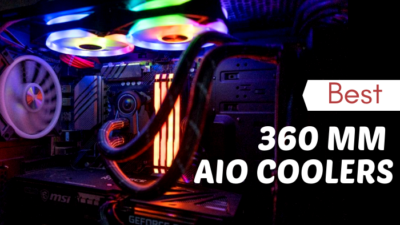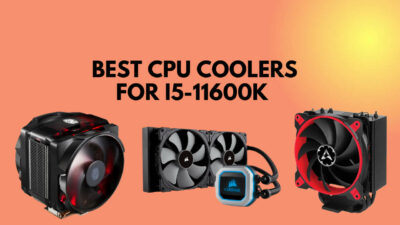Your new CPU cooler just arrived, and you’ve figured out the installation process. The only question on your mind now is:
What’s the proper CPU cooler fan direction?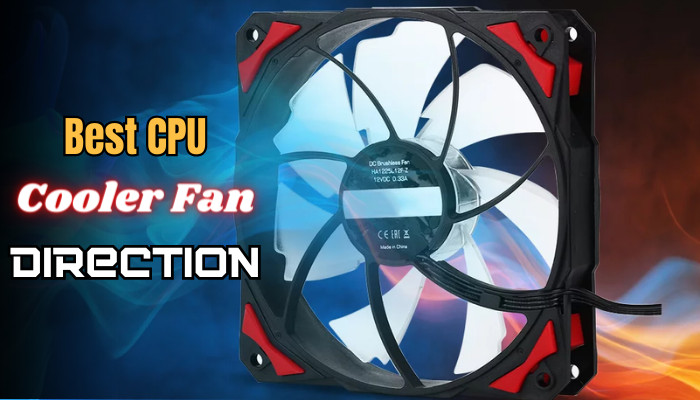
Worry not, as you’re not the only person asking the question. I’ll provide you with every detail you need to know.
So, don’t skip any part, as every section contains important information.
What is the Proper CPU Cooler Fan Direction?
The proper CPU cooler fan direction is to drive cool air through the heatsink to eject the hot air through the rear exhaust of the PC case. The front case fans will pull in cool air while the rear case fans will push the hot air out. The general airflow direction will be front-to-back.
As the CPU cooler is necessary for your PC, the fan needs to be set up in such a way that the airflow is optimal.
Most of the time, the PC airflow is set up in a front-to-back orientation. Meaning the front of the case will pull in cool air, which will go through the fan and heatsink of the CPU cooler. Then, the hot air coming off the heatsink will be evacuated with the help of an exhaust casing fan through the back of the case.
Therefore, most of the time, the proper direction of the fan of the CPU cooler is to push the hot air from the CPU cooler heatsink toward the rear exhaust.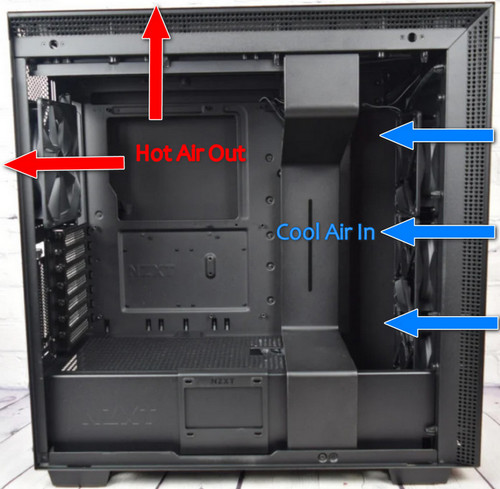
Now, this isn’t the only way to do things. If you wanted, you could switch up and use the back for the intake and put the exhaust fans at the front, and then find the right orientation. This is known as back-to-front configuration.
This Back-to-front method pulls the cool air into the chassis from the back and removes hot air through the front. It’s simply the opposite, and the fans are optimized reversely.
This procedure is related to the positive vs. negative airflow concept. In positive airflow, the amount of cool air drawn into the case is greater than the amount of hot air pushed out of the case. In negative airflow, it’s the opposite, as a vacuum is created by the exhaust fans.
So, in positive airflow, the number of intake fans is greater, and in negative airflow, exhaust fans are higher in number.
Though positive airflow is recommended, it has an added disadvantage: Dust accumulation is greater. But it can be countered by using better dust filters or regular cleaning.
If you have a beefy discrete graphics card, the hot air will be pushed by the GPU cooling fans upwards and toward the CPU. Since hot air is lighter and goes up, you would want to exhaust the hot air through the rear and top of the case.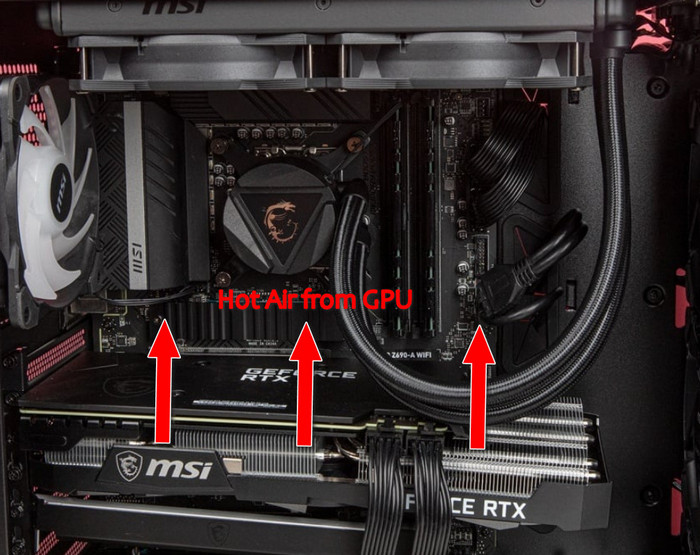
That’s another reason for using the front-to-back airflow direction and letting fans of the CPU cooler push air directly to the rear exhaust.
Depending on your PC’s case, the existence of a GPU, the number of intake and exhaust fans, the existence of a radiator, etc., the best direction for the CPU cooler fan will vary.
But for most cases (pun intended), the front-to-back orientation gives the best outcome.
Hence, if you are wondering which way you should point the CPU cooler, then the best place to point it is toward the exhaust fan.
What are the Parameters to Choose the Best CPU Fans?
The dependencies I spoke of earlier can affect the PC case interior extensively. But first, you must know how different fans work in different ways. For instance, a static pressure fan is suitable for air intake, as well as at the front position.
Most PC Cases have a glass panel & dust filter at the front, where the airflow must enter through certain resistance. The Airflow fan isn’t effective in such cases.
The static pressure fan is preferred even if your PC Case has a mesh design at the front; because the mesh is also resistant. But the back of your case has vents with larger cavities, and the resistance is minimum.
Therefore, high volume airflow(CFM) is required for the back with Airflow type fans. These fans have much RPM– Rotation Per Minute with high CFM-cubic feet /meter air.
Especially when a vertical CPU cooler is your choice, you must ensure a larger air volume air一 measured with CFM. The Fan rotation speed is evenly essential for such a large air passthrough. As a result, vertically installed CPU coolers need two Airflow fans for an effective push-pull configuration.
Either you have a split heatsink or a single tower; both fans must inhale air from the front PC case direction and exhaust to the back, meaning CPU fans must stay in the same direction. You can also replace the CPU cooler’s fan for better airflow.
Alternatively, The AIO CPU coolers need static pressure fans instead of Airflow fans, as those fans must draw air through the radiator. A rig with AIO must keep the fan count balanced. For example, if your PC has three Fans for intake, ensure at least two or three fans for exhaust.
Pro Tip: You should place your AIO radiator at the front to inhale cool air from the outside. Because installing the radiator at the top can attract more dust. And setting up the AIO fan for exhaust at the back is bad, as air flowing from GPU & components is hot and inappropriate for cooling the radiator.
Does the Fan Direction for the CPU Cooling Make a Difference?
Yes, the fan direction matters one hundred percent for CPU cooling. It’s common knowledge that the airflow inside the case and through to the outside is very important. In fact, the CPU cooler fan direction should match the PC case airflow direction for efficient cooling.
For context, let’s take an Intel factory cooler as an example. The airflow in that is downwards through the heat sink and then out in every direction in your case. 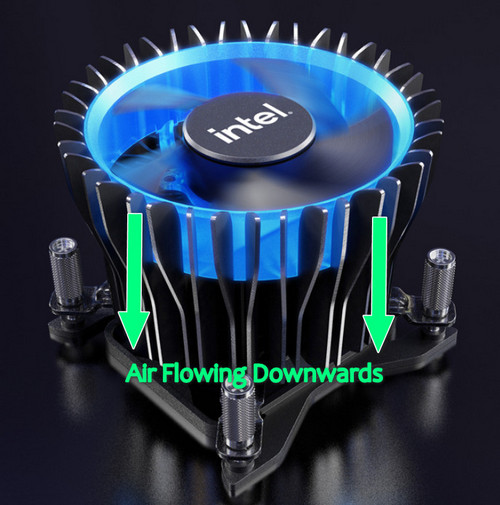
On the other hand, in a CPU cooler with a vertical arrangement like the Hyper Evo 212, the air is pushed through the fans, and then you will have to point it toward the back of your case.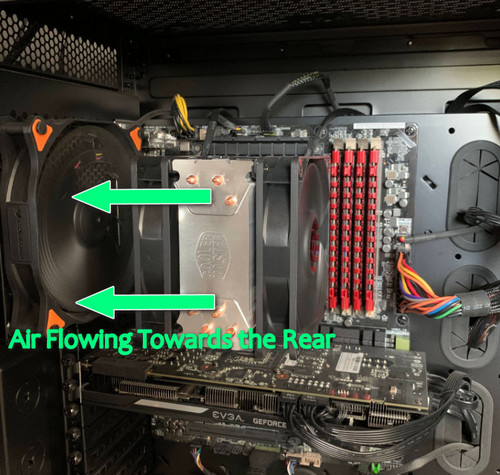
One thing to keep in mind while positioning the fans is to never point fans at each other in the opposite direction, as the results would probably end up being unstable or inefficient thermals.
You want to match the CPU cooler airflow with the desktop PC case airflow. This will ensure hot air and cool air do not mix up and reduce the efficiency of the airflow inside the case.
As I’ve said earlier, the best direction for the CPU cooler fan will be different depending on your PC case, GPU, number of case fans, radiator, etc. So, there are a lot of variables that’ll determine the best direction of the fan of the CPU cooler.
Depending on your setup, you should pattern the PC airflow optimization to maximize cooling for the PC. Front-to-back airflow is the best configuration if you have a typical gaming PC with a discrete GPU.
Otherwise, if you have a high-end CPU with high wattage, beefy GPUs, a special type of PC case, and AIO cooling, then the direction of the fan of the CPU cooler will depend on your exact setup. Also, the type of fans will vary (for example, fans with high static pressure are recommended for radiators).
What Direction Should the Heatsink Fan Face?
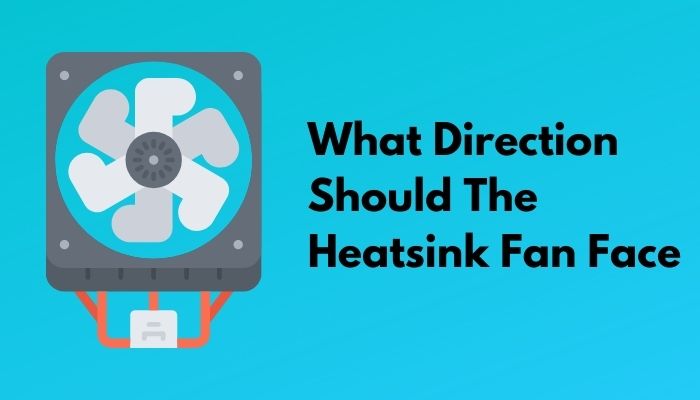
If you have a CPU cooler that sits on the CPU, the heatsink fan should face the direction opposite of the CPU. Then the fan will push cool air into the heatsink and out through the back. If you have a dual tower or single tower CPU cooler, the heatsink fan should match the casing airflow direction.
The direction of the fan matters to ensure the optimal cooling of the PC. Fan direction is one of the important points to consider to make the CPU cool and ensure better flow inside the case.
In the case of a CPU cooler that sits parallel to the CPU, the heatsink fan should face you when you’re mounting it. In other words, you have to make sure the front of your CPU fan is facing the back of the heatsink. This is because it pushes a cool breeze down between the blades and out the back.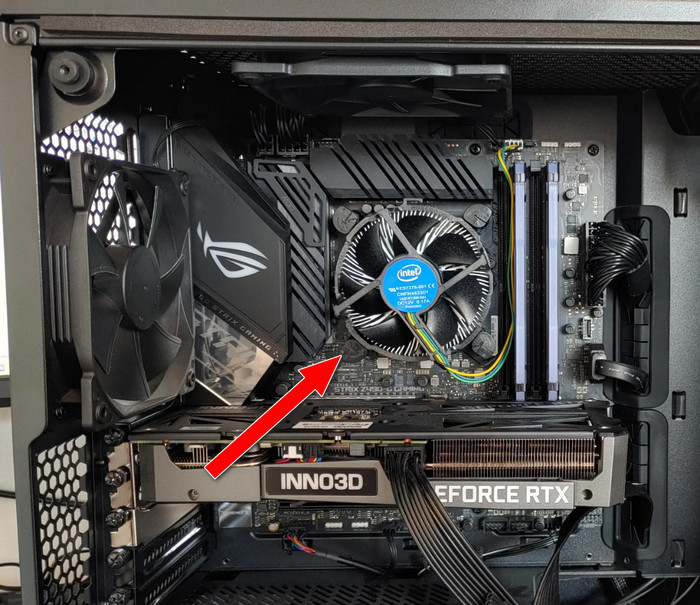
In the case of a tower CPU air cooler, the heatsink fan should be oriented such that it merges with the PC case airflow.
So, if the PC case airflow is front-to-back, the heatsink fan should face the front of the case so that it takes the cool breeze from the front and pushes hot air out the back towards the rear exhaust.
Countless cooling variations are available for tower coolers, but every variation has either one of the two types of airflow. The two types of airflow to cool the tower cooler heatsink are:
- Forced Cooling: In this case, the cold air is pushed on the heatsink solely for the purpose of cooling.
- Induced Cooling: This is the scenario where the hot air is drawn from the surface of the heatsink, which allows the space to be filled with fresh cool air, and the place stays cool.
Now, you’ll also want to know: How do I ensure which method is most suitable?
Induced cooling is recommended when there is more potential to bring in a lot of fresh air from outside and also if the surface to be cooled is quite large.
On the contrary, forced cooling benefits when the air input to the surface is very limited and the surface that needs to be cooled is small.
It is best to try both methods and see the temperature difference. PC builders tested that in a typical setup, the difference would be negligible, and one option would be slightly warmer than the other. You can choose the best airflow PC case for maximum performance.
You can opt for either method. But in special cases, you might benefit from any one of them and should stick to it.
How to Tell CPU Fan Direction
The fan direction is mostly generic, and the majority of manufacturers follow a pattern. All CPU fan blades are connected to a base or rotor or bearing motor affixed with an X-shaped or brand sticker’s opposite, which is the rear and exhaust. Plus, some fans have marked direction too.
If you’re confused about which side of the fan takes air in and which side pushes air away, I’ve clarified the different methods of figuring it out below:
1. Check the Front and Back
Typically, the front of the fan (where you have the branding sticker) is the intake, and the back of the fan (where the technical details are written) is the exhaust.
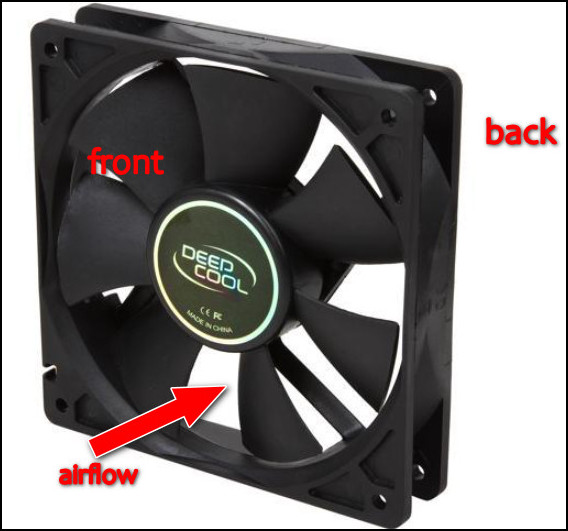
Since the back of the fan has an X-shaped support (look at the fan blades where they connect to the frame), the side with the X-shaped support is the exhaust.
2. Follow the Arrow Sign
Most fans will have small arrows printed that point toward the exhaust. So, the air flows from the tail of the arrow toward the head of the arrow.
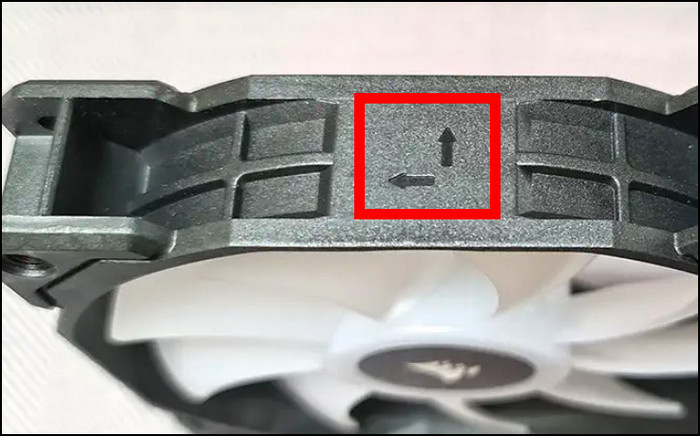
3. Power the Fan
If you connect the fan to an external power source (such as a battery), it’ll start to spin, and you can feel with your hands the direction of airflow. Connect the red and black wires of the fan to the corresponding ends of the battery to power the fan.
Instead, you can connect the fan you’re using to the motherboard (SYS_FAN pins for the case fan and CPU_FAN pins for the CPU fan) and power the motherboard. Then the fan should spin, and you can check the direction of fan airflow.
4. Read the Manuals
If the fans come with a user manual, you can go through it to read about the airflow direction. Otherwise, you can go through the website of the fan manufacturer.
How Often Should You Dust Your Fan?
It is extremely important that you dust your fan at least once a month. Don’t forget to turn off the PC and disconnect the PSU before checking for dust on the blades and housing. Making sure your fans are clean will actually boost your CPU performance as well.
I’m saying this because no matter what position you put your fans in, you will still need to clean your fans from time to time for better airflow. You could have your fan in the world’s most optimal position, and it would still manage to get filled with dust without proper maintenance.
You can minimize the amount of dust getting accumulated by making sure that the air flowing into the case is passing through a filter first.
Most of the cases have these filters, and they are removable as well, so you will be able to clean them very easily with a quick rinse.
All you have to do is just make sure to clean these filters every few weeks or so. If you leave your filters dirty and unmaintained, it will have a negative impact on the airflow and cooling power.
FAQs
Should AIO fans be intake or exhaust?
Answer: Intake is better for the surface that needs to be cooled by the AIO. The same cannot be said for the system. The CPU performance won’t degrade as long as it’s below the throttling range.
Is positive or negative airflow better?
Answer: You should aim for somewhat positive pressure. Negative pressure would suggest that air is getting sucked into your case due to many tiny gaps that you can’t control, which means less efficient cooling over time.
Do GPU fans push or pull?
Answer: Well, generally, you will find GPU fans pull air into the heat sink. A few coolers come with the ability to expel the hot air generated outside the case simply. Some cards expel the hot air back into the case.
Can you mount a CPU cooler sideways?
Answer: Yes, that is definitely possible and is pretty common nowadays so you have nothing to worry about.
How tight should you screw the CPU cooler?
Answer: All you have to do when tightening screws is just make sure they are quite snug. You don’t really want to over-tighten them.
Final Thoughts
Many people ignore a very important step when installing their CPU cooler, and that is installing the fan of the CPU cooler in a very optimal position.
Thankfully, you are not one of them, and I hope you know exactly which position to place your fan in now while building a PC.
If you are interested in more tech guides and fixes, make sure to visit our homepage to get all your confusion cleared.

